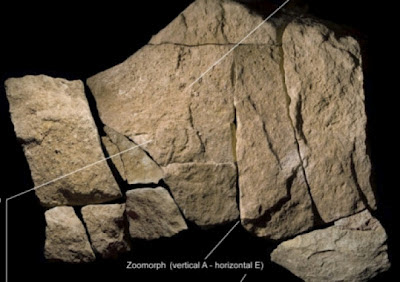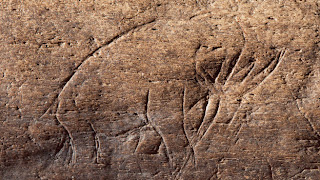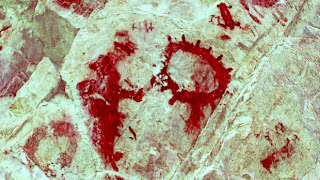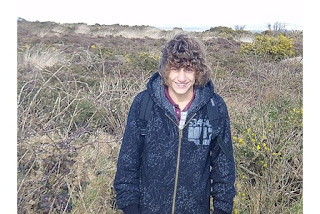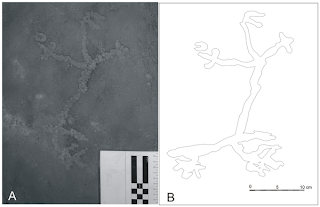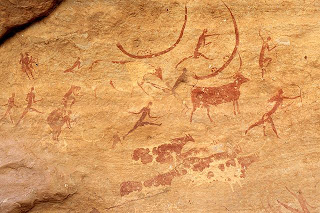Plans to help fund a giant facsimile of the Lascaux caves in the Dordogne have been scrapped under government cuts - but local councillors say they will save the €50million project.
Culture Minister Aurélie Filippetti said that several cultural projects announced by the previous government - totalling almost a billion euros but mostly unbudgeted - would be scrapped, delayed or postponed.
These included the Lascaux 4 reconstruction near Montignac, the Maison de l'Histoire de France national history museum, a reserve art store for the Louvre at Cergy-Pontoise, and an extra theatre for the Comédie-Française.
Ms Filipetti said that Lascaux 4 was "not a priority project" but Bernard Cazeau, president of Dordogne conseil général, said that was "surprising" as the plans to safeguard the hillside above Lascaux were laid under instructions from the government and Unesco.
Showing posts with label rock art. Show all posts
Showing posts with label rock art. Show all posts
Wednesday, September 12, 2012
Lascaux 4 plans axed in €1bn cuts
Email ThisBlogThis!Share to TwitterShare to FacebookShare to Pinterest
Monday, August 13, 2012
Wemyss caves group says carving could date from 12th century
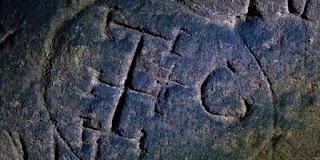 |
| The carving found in the Well Cave. |
The East Wemyss coastal area boasts 12 caves, the largest grouping in northern Europe.
Moira Cook of Save the Wemyss Ancient Caves Society (SWACS) said: ''The symbols were discovered in the Well Cave. We have asked experts for their opinion.
''There is a possibility of some sort of Templar connection. It's all very exciting.''
Local archaeologist Edwina Proudfoot added: ''An early carving would be a great find, but understanding what can be seen is also important.''
The Well Cave is below MacDuff Castle and was not thought to contain Pictish carvings, until the recent discovery by SWACS members.
The group was first formed by locals in 1986 following a spate of vandalism at the caves.
To find out more about the group, who run regular tours, visit www.wemysscaves.co.uk
Source: The Courrier
Email ThisBlogThis!Share to TwitterShare to FacebookShare to Pinterest
Friday, June 29, 2012
Welsh Reindeer Is Britain's Oldest Rock Art, U-Series Dating Suggests
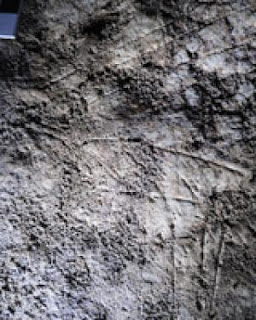 |
| The image was carved using a sharp-pointed tool, probably made of flint. Credit: Dr George Nash |
The engraving was discovered in September 2010 by Dr George Nash from the University of Bristol's Department of Archaeology and Anthropology while he was exploring the rear section of Cathole Cave, a limestone cave on the eastern side of an inland valley on the Gower Peninsula, South Wales.
Found to the rear of the cave on a small vertical limestone niche, the engraved cervid -- probably a stylised reindeer -- is shown side-on and measures approximately 15 x 11cm. It was carved using a sharp-pointed tool, probably made of flint, by an artist using his or her right hand. The animal's elongated torso has been infilled with irregular-spaced vertical and diagonal lines, whilst the legs and stylised antlers comprise simple lines.
The reindeer was engraved over a mineral deposit known as a 'speleothem' (cave formation), which itself developed over a large piece of limestone. Extending over the left side of the figure is a flowstone deposit (speleothem cover) which extends across part of the animal's muzzle and antler set.
In April 2011, Dr Peter van Calsteren and Dr Louise Thomas of the NERC-Open University Uranium-series Facility extracted three samples from the surface of the speleothem covering the engraving. One of these samples produced a minimum date of 12,572 years BP (before present), with a margin of plus or minus 600 years. A further sample, taken in June 2011 from the same flowstone deposit, revealed a minimum date of 14,505 years BP, plus or minus 560 years.
Dr Nash said: "The earlier date is comparable with Uranium-series dating of flowstone that covers engraved figures within Church Hole Cave at Creswell along the Nottinghamshire/Derbyshire border. However, the new minimum date of 14,505 + 560 years BP makes the engraved reindeer in South Wales the oldest rock art in the British Isles, if not North-western Europe."
Source: University of Bristol
Found to the rear of the cave on a small vertical limestone niche, the engraved cervid -- probably a stylised reindeer -- is shown side-on and measures approximately 15 x 11cm. It was carved using a sharp-pointed tool, probably made of flint, by an artist using his or her right hand. The animal's elongated torso has been infilled with irregular-spaced vertical and diagonal lines, whilst the legs and stylised antlers comprise simple lines.
The reindeer was engraved over a mineral deposit known as a 'speleothem' (cave formation), which itself developed over a large piece of limestone. Extending over the left side of the figure is a flowstone deposit (speleothem cover) which extends across part of the animal's muzzle and antler set.
In April 2011, Dr Peter van Calsteren and Dr Louise Thomas of the NERC-Open University Uranium-series Facility extracted three samples from the surface of the speleothem covering the engraving. One of these samples produced a minimum date of 12,572 years BP (before present), with a margin of plus or minus 600 years. A further sample, taken in June 2011 from the same flowstone deposit, revealed a minimum date of 14,505 years BP, plus or minus 560 years.
Dr Nash said: "The earlier date is comparable with Uranium-series dating of flowstone that covers engraved figures within Church Hole Cave at Creswell along the Nottinghamshire/Derbyshire border. However, the new minimum date of 14,505 + 560 years BP makes the engraved reindeer in South Wales the oldest rock art in the British Isles, if not North-western Europe."
Source: University of Bristol
Email ThisBlogThis!Share to TwitterShare to FacebookShare to Pinterest
Tuesday, June 26, 2012
Australian Cave Painting Found To Be One of World's Oldest
Email ThisBlogThis!Share to TwitterShare to FacebookShare to Pinterest
Wednesday, June 20, 2012
Firefighter discovers Neolithic rock art at the Spanish-Portuguese border
Destiny seems obsessed with rock-art these days. Juan Carlos Jiménez, forest firefighter at Valencia de Alcántara at the Spanish-Portuguese border, in Extremadura, discovered several Neolithic rock art weeks ago at San Roque pass and other mountain locations (Sierras of San Pedro and Santa Catalina).
Archaeological experts from the regional government estimate the age of these paintings on 3500 to 2250 years BCE.
Examples of the findings:
Source: Radio Interior.es via Terrae Antiqvae
Archaeological experts from the regional government estimate the age of these paintings on 3500 to 2250 years BCE.
Examples of the findings:
Source: Radio Interior.es via Terrae Antiqvae
Email ThisBlogThis!Share to TwitterShare to FacebookShare to Pinterest
Tuesday, June 19, 2012
Clottes questions the dates of Iberian rock art
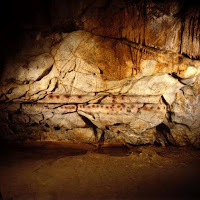 |
| Red dots from El Castillo, one of which is claimed to be older than 40,000 years |
Another highly reputed expert questioning the dating is Hellene Valladas, who dated Grotte Chauvet.
Sources: Pileta, Bradshaw Foundation, Bloomberg.
Email ThisBlogThis!Share to TwitterShare to FacebookShare to Pinterest
Friday, June 1, 2012
Simek to hold local cave art presentation at Palace Theatre
 |
| Dr. Jan Simek |
Rain leaching through the soft layers of sandstone that make up the Plateau carved out numerous caves. With at least 9,600 caves in Tennessee, more caves are found here than in any other part of the U.S.
Dr. Jan Simek, professor of anthropology at the University of Tennessee in Knoxville and a leading expert on prehistoric cave art in the southeastern United States, has made a career of studying ancient drawings and pictographs in caves around the world, including Devil’s Step Hollow Cave in Cumberland County. Dr. Simek’s publications on caves appear in several books, including Discovering North American Rock Art, and The Rock-Art of Eastern North America: Capturing Images and Insight.
Devil’s Step Hollow Cave in Cumberland County contains one of the oldest and largest collections of Native American art in the U.S., said to be over 1,000 years old. To preserve this legacy, Devil’s Step Hollow Cave has been sealed to the public. However, Dr. Simek will be in Crossville Tuesday, June 26 at the Palace Theatre, 72. S. Main St., for a presentation of the photographs and history of these petroglyphs and pictographs. The photography of this ancient art is by Alan Cressler of Chattanooga.
Sponsorship for this program about the fascinating early history of the county is by the city of Crossville, PEG Broadcasting and the Crossville Chronicle.
Coordinating this effort have been Billy Loggins for the city of Crossville, Ann Looney of Arts Roundup and Sharron Eckert of CACE and the Shanks Center for the Arts. They will welcome you at the Palace Theatre for a reception at 5 p.m. Dr. Simek’s presentation will begin at 6 p.m.
Admission is free, but a ticket is required for admission. Tickets are available at the Palace Theatre, the Shanks Center for the Arts, First National Bank on Peavine Rd. and at Cumberland Eye Care (Dr. Galloway) on Peavine Rd.
Following the presentation, there will be a free exhibition of Alan Cressler’s photographs of the cave art from Devil’s Step Cave Thursday, July 5 through Friday, Aug. 31 at the Shanks Center for the Arts, 140 N. Main St. across from the Crossville Depot.
For more information, contact the Palace Theatre at 484-6133, or the Shanks Center for the Arts at 787-1936.
Email ThisBlogThis!Share to TwitterShare to FacebookShare to Pinterest
Tuesday, May 15, 2012
Video: The Prehistoric Cave Art Of Cantabria, Spain
Email ThisBlogThis!Share to TwitterShare to FacebookShare to Pinterest
Cave women in a different light
| Abri Castanet |
He and his colleagues report their findings in the current issue of The Proceedings of the National Academy of Sciences.
The drawings include what appear to be images of the female vulva, illustrated by circles with small slits on one side. ''You see this again and again and again,'' Professor White said. There are also very simple images, in profile, of animals, including horses and lion-like big cats, he said.
Advertisement: Story continues below
The work was discovered on a collapsed roof of a rock shelter at the Abri Castanet site in the Vezere River valley in south-west France. Humans at the time lived in such shelters, Professor White said, and it was a period of cultural emergence. ''They were working with ivory beads and other personal ornamentation,'' he said. ''They were decorating their bodies in complex ways.''
Professor White and his team are continuing their excavation work at the site and hope that by deciphering more of the art, they can understand the culture of the people better. ''What we hope to be able to do is map the distribution of images on the ceiling and all of the activities of the time,'' he said. ''There may be a relationship between the art on the ceiling and their lives.''
The work is less sophisticated than the elaborate paintings of animals found in France's Grotte Chauvet, which was more remote and difficult to access, believed to be between 30,000 and 36,000 years old. The engravings and paintings at Castanet are rougher and more primitive in style, and were likely done by everyday people.
''This art appears to be slightly older than the famous paintings from the Grotte Chauvet in south-eastern France,'' Professor White said. ''But unlike the Chauvet paintings and engravings, which are deep underground and away from living areas, the engravings and paintings at Castanet are directly associated with everyday life, given their proximity to tools, fireplaces, bone and antler tool production, and ornament workshops.''
Source: SMH
Email ThisBlogThis!Share to TwitterShare to FacebookShare to Pinterest
Wednesday, April 4, 2012
Google takes African rock art online
Ancient African cave paintings will become available online as Google partners with the South African National Gallery and Wits Rock Art Research Institute.
Art from the Giant's Castle Nature Reserve and Kamberg Nature Reserve will go online as well as several works by artists such as Sophie Peters, Thami Mnyele and Alexis Preller. Virtual visitors can browse them via Google's Art Project.
"We encourage you to come to make a pilgrimage to these special sites. Be inspired - by visiting these sites you will not only have a life changing journey into the African past, you will be helping to preserve our priceless heritage for future generations," said Professor Benjamin Smith, director of the Rock Art Research Institute.
The project is part of Google's programme of illustrating unique sites, including the Amazon and a recent partnership with the Catlin Seaview Survey which allows visitors to have a 360° view of the Great Barrier Reef.
"Through the Art Project we’re aiming to bring local history and culture online and make it accessible," said Dr Julie Taylor, Google's head of communications for Sub-Saharan Africa.
Source: News 24
Art from the Giant's Castle Nature Reserve and Kamberg Nature Reserve will go online as well as several works by artists such as Sophie Peters, Thami Mnyele and Alexis Preller. Virtual visitors can browse them via Google's Art Project.
"We encourage you to come to make a pilgrimage to these special sites. Be inspired - by visiting these sites you will not only have a life changing journey into the African past, you will be helping to preserve our priceless heritage for future generations," said Professor Benjamin Smith, director of the Rock Art Research Institute.
The project is part of Google's programme of illustrating unique sites, including the Amazon and a recent partnership with the Catlin Seaview Survey which allows visitors to have a 360° view of the Great Barrier Reef.
"Through the Art Project we’re aiming to bring local history and culture online and make it accessible," said Dr Julie Taylor, Google's head of communications for Sub-Saharan Africa.
Source: News 24
Email ThisBlogThis!Share to TwitterShare to FacebookShare to Pinterest
Monday, March 26, 2012
Two New Caves With Rock Art Discovered In India
 |
| Maraiyur, located near Udumalaipettai, houses many Neolithic and megalithic structures made of stone and granite. |
Sharing his discovery with Express, C Vijayakumar says Vanapechialai has a large number of faded red-ochre paintings. “There are six red hand marks and certain unidentifiable images. However, there are six bright parallel lines in a zig zag fashion in red ochre resembling flickering of flames.” In the same cave, there is also a white-ochre painting, which portrays a man seated on an elephant (22 cm long, 18 cm wide). Vijayakumar says the white-ochre drawing has been done over red-ochre.
The Vanaraparai cave has the famed ‘hand’ mark, which is early man’s first effort in documenting his identity. “It is imprinted twice in pure red-ochre. In the right hand, the ring finger is missing, suggesting that the imprint is that of the village chieftain or Moopan. In primitive societies during pre-historic period, the Moopan’s ring finger was always cut.”
The cave - big enough to house 150 cows - has paintings ranging between 5 cm and 32 cm. There are altogether 28 sketches of early man, besides images of animals, which include a couple of elephants, men on deer with a primitive hunting weapon, monkeys, the sun and a faded moon.
Email ThisBlogThis!Share to TwitterShare to FacebookShare to Pinterest
Sunday, March 18, 2012
Re-examine rare fossil find site, there likely are others, archaeologist urges during Vero Beach presentation
Noted British archaeologist and Ice Age art expert Paul Bahn came to Indian River County to examine the carved fossil bone found in Vero Beach in 2009 that is the only Pleistocene era artifact of its kind found in North America.
On Sunday afternoon, Bahn, who is also an author, translator and BBC commentator, spoke at the Emerson Center during a presentation hosted by the Old Vero Ice Age Sites Committee. While most of Bahn's presentation focused on Ice Age cave art in Europe, he outlined several findings that might offer lessons for future excavations or studies of the Vero Man site.
The committee is raising money to fund a re-excavation of the site, and an international team recently completed a site survey with ground-penetrating radar. Committee chairwoman Susan Grandpierre told the crowd of about 200 attendees that the survey's preliminary findings reveal undisturbed ground that might contain artifacts like the one found by James Kennedy, but the final survey results are not available.
Kennedy's find was a carving of a mammoth on what is thought to be a mammoth or sloth bone, and was authenticated by scientists at the University of Florida. It is thought to be 13,000 to 20,000 years old. Excavating the Vero Man site, which was discovered in 1913 and is one of only two locations in the United States where fossilized human remains have been discovered alongside a variety of Ice Age, or Pleistocene, mammal remains, is expected to cost about $1.3 million, according to Grandpierre.
On Sunday afternoon, Bahn, who is also an author, translator and BBC commentator, spoke at the Emerson Center during a presentation hosted by the Old Vero Ice Age Sites Committee. While most of Bahn's presentation focused on Ice Age cave art in Europe, he outlined several findings that might offer lessons for future excavations or studies of the Vero Man site.
The committee is raising money to fund a re-excavation of the site, and an international team recently completed a site survey with ground-penetrating radar. Committee chairwoman Susan Grandpierre told the crowd of about 200 attendees that the survey's preliminary findings reveal undisturbed ground that might contain artifacts like the one found by James Kennedy, but the final survey results are not available.
Kennedy's find was a carving of a mammoth on what is thought to be a mammoth or sloth bone, and was authenticated by scientists at the University of Florida. It is thought to be 13,000 to 20,000 years old. Excavating the Vero Man site, which was discovered in 1913 and is one of only two locations in the United States where fossilized human remains have been discovered alongside a variety of Ice Age, or Pleistocene, mammal remains, is expected to cost about $1.3 million, according to Grandpierre.
Email ThisBlogThis!Share to TwitterShare to FacebookShare to Pinterest
Friday, March 16, 2012
Once thought lost, the rock-art images of ancient peoples are seen again
Stones were once canvas for stories. We marked milestones and journeys on rocks, painting vivid images of big hunts, mighty warriors and spiritual quests. Tens of thousands of tales have been told in bright shades of ochre - stories that, under the stress of weather and time, have been fading from our landscape. Lost forever in some cases, or so we thought.
The digital age is breathing new life into ancient rock art around the globe, from Mexican caves to the Sahara Desert to the mountains and foothills of Western Canada. With the help of NASA-inspired software called DStretch, pictographs no longer visible to the naked eye are being revived, giving cultural archivists a fresh look into the past and a vital new preservation tool.
The software has allowed Parks Canada to uncover myriad hidden treasures at aboriginal pictograph sites in British Columbia and Alberta. Forgotten tales are resurfacing.
“It opens an entirely new chapter in rock art analysis and … rock art preservation,” said Parks Canada archeologist Brad Himour. “DStretch has the ability to bring back images and pictographs that we would have thought of as being lost up until just very recently.”
The digital age is breathing new life into ancient rock art around the globe, from Mexican caves to the Sahara Desert to the mountains and foothills of Western Canada. With the help of NASA-inspired software called DStretch, pictographs no longer visible to the naked eye are being revived, giving cultural archivists a fresh look into the past and a vital new preservation tool.
The software has allowed Parks Canada to uncover myriad hidden treasures at aboriginal pictograph sites in British Columbia and Alberta. Forgotten tales are resurfacing.
“It opens an entirely new chapter in rock art analysis and … rock art preservation,” said Parks Canada archeologist Brad Himour. “DStretch has the ability to bring back images and pictographs that we would have thought of as being lost up until just very recently.”
Email ThisBlogThis!Share to TwitterShare to FacebookShare to Pinterest
Thursday, March 15, 2012
Teen will chart Namibian caves
A teenager from Stithians is raising funds for a scientific expedition to Namibia later this year.
Morgan Whittaker, 15, has managed to secure one of only 28 places nationwide for the five-week trip.
He said: "This will not be a holiday, but a test of survival skills, while carrying out important scientific projects."
The first part of the fieldwork will be in the desert mountains, known as the Brandberg Massif, and involve climbing, abseiling and caving.
Prehistoric paintings in the cave networks have been observed and documented since the early 20th century, but they have never been mapped, which will form the basis for the work in that area.
The next part of the fieldwork will be based in the savannah grasslands monitoring the elephant herds in conjunction with Elephant-Human Relations Aid (EHRA).
This will involve tracking, observation and recording of accurate data while trekking in an area of big game.
Morgan Whittaker, 15, has managed to secure one of only 28 places nationwide for the five-week trip.
He said: "This will not be a holiday, but a test of survival skills, while carrying out important scientific projects."
The first part of the fieldwork will be in the desert mountains, known as the Brandberg Massif, and involve climbing, abseiling and caving.
Prehistoric paintings in the cave networks have been observed and documented since the early 20th century, but they have never been mapped, which will form the basis for the work in that area.
The next part of the fieldwork will be based in the savannah grasslands monitoring the elephant herds in conjunction with Elephant-Human Relations Aid (EHRA).
This will involve tracking, observation and recording of accurate data while trekking in an area of big game.
Email ThisBlogThis!Share to TwitterShare to FacebookShare to Pinterest
Sunday, March 11, 2012
Did Stone Age cavemen talk to each other in symbols?
 |
| Some of the symbols found to recur among Palaeolithic cave paintings and other artefacts. Photograph: Genevieve von Petzinger |
Visit the caves of Pech Merle, Font-de-Gaume and Rouffignac in southern France and you will witness some of the most breathtaking art our planet has to offer. Images of bisons, lions and other creatures loom from the cavern walls. Herds of horses and the occasional rhino, not to mention the odd mammoth and giant bull, parade across the rocks. Many animals are depicted in vivid colours, with a sense of perspective and anatomical detail that suggest these artists had acquired considerable skill.
These underground galleries, found mostly in France and Spain, also turn out to be remarkably old. The works at Rouffignac have been dated to around 13,000 years old, while those at nearby Chauvet and Lascaux are thought to be more than 30,000 years old. This testimony on rock walls - in daubs of ochre and charcoal mixed with spittle and fat - shows that our hunter-gatherer ancestors could depict the world around them in a startlingly sophisticated way. As the art critic John Berger once said of these painters, they appear to have had "grace from the start". Picasso was even more awestruck. "We have invented nothing," he remarked gloomily, after a visit to Lascaux in 1940 to inspect the handiwork of his Stone Age predecessors.
Email ThisBlogThis!Share to TwitterShare to FacebookShare to Pinterest
Thursday, March 8, 2012
Call to save 'slave' cave carvings at Guy's Cliffe House
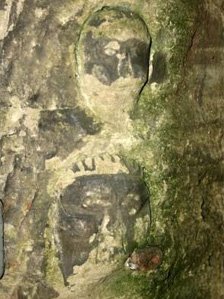 |
| The caves could have been used as dormitories for slaves a group claims. |
The Sparkbrook Caribbean and African Women's Development Initiative (SCAWDI) claims three carvings in caves alongside Guy's Cliffe House, near Warwick, were made by slaves in the 17th Century and deserve to be preserved for the nation.
"I haven't seen anything like it outside Africa. It's the only one of its kind in Europe," Barbara Willis-Brown, director of SCAWDI, said.
Ms Willis-Brown added: "In 1751, Samuel Greatheed returned from his plantations in St Kitts and started to build the house.
"A noted slave trader, we believe, rather than pay wages, he brought slaves over to help in its construction."
Ms Willis-Brown said Samuel Greatheed was one of the most prominent slave traders in the Caribbean and later received the large sum of £25,000 in compensation from the government following the abolition of the slave trade.'Incredibly important'
She added: "The caves would probably have been used as dormitories.
"They're obviously Negro features. We think they carved their faces here, hoping they would be found one day."
Email ThisBlogThis!Share to TwitterShare to FacebookShare to Pinterest
Tuesday, February 28, 2012
'Naked Archaeologist' finds signs Jerusalem cave was used to bury Jesus' disciples
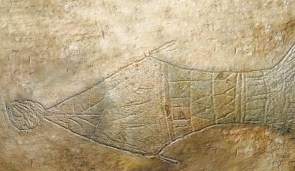 |
| Enhanced image of 'Jonah and the Whale' found in a Jerusalem burial cave. |
Under an ordinary residential building in Jerusalem's Armon Hanatziv neighborhood, a robotic arm with a camera inserted into a Second Temple-era burial cave has revealed mysterious inscriptions and drawings on ossuaries.
Simcha Jacobovici, an Emmy-winning documentary director and producer who is best known for his documentary TV series "The Naked Archaeologist," argues that the cave served as a burial cave for at least some of Jesus' disciples.
Jacobovici is exploring the cave for his latest documentary project, backed by the Discovery Channel, and hopes his findings substantiate his earlier theory that a nearby cave is the one where Jesus was buried. He made that claim in a previous documentary, and said the theory was backed up by the names found on the ossuaries, or receptacles for bones, in the cave.
The discoveries could potentially have revolutionary implications for the understanding of early Christianity and of Jesus as a historical figure.
Email ThisBlogThis!Share to TwitterShare to FacebookShare to Pinterest
Oldest New World Cave Art Discovered
A figure engraved in the bedrock of a Brazilian cave dates back at least 10,000 years.
Cave painting connects us with our prehistoric artist ancestors. But there’s a dearth of such illustration in the Americas. Now a cave in Brazil has been found to house the oldest New World image known.
The shelter was excavated from 2002 to 2009. In the last days there, scientists exposed a foot-high figure in the bedrock. It has a c-shaped head, two outstretched arms, two legs, and a very visible penis.
Using radiocarbon dating, the researchers dated an ash layer to between 9300 and 10,500 years ago. A hearth found about an inch above the drawing gives similar results. And the researchers used a technique called optically stimulated luminescence on sediment, which also dated to around 10-12,000 years ago.
The scientists say this makes the petroglyph the oldest reliably dated cave art in the Americas. The research was published in journal Public Library of Science One.
[WA Neves et al, Rock Art at the Pleistocene/Holocene Boundary in Eastern South America]
Echoes of this style exist in other early art in the region, amidst diverse styles throughout North and South America. The researchers the range of images reveals a spectrum of symbolic thought dating back to early in the history of human colonization of the hemisphere.
Also available as podcast: Download MP3
Source: Scientific American
Cave painting connects us with our prehistoric artist ancestors. But there’s a dearth of such illustration in the Americas. Now a cave in Brazil has been found to house the oldest New World image known.
The shelter was excavated from 2002 to 2009. In the last days there, scientists exposed a foot-high figure in the bedrock. It has a c-shaped head, two outstretched arms, two legs, and a very visible penis.
Using radiocarbon dating, the researchers dated an ash layer to between 9300 and 10,500 years ago. A hearth found about an inch above the drawing gives similar results. And the researchers used a technique called optically stimulated luminescence on sediment, which also dated to around 10-12,000 years ago.
The scientists say this makes the petroglyph the oldest reliably dated cave art in the Americas. The research was published in journal Public Library of Science One.
[WA Neves et al, Rock Art at the Pleistocene/Holocene Boundary in Eastern South America]
Echoes of this style exist in other early art in the region, amidst diverse styles throughout North and South America. The researchers the range of images reveals a spectrum of symbolic thought dating back to early in the history of human colonization of the hemisphere.
Also available as podcast: Download MP3
Source: Scientific American
Email ThisBlogThis!Share to TwitterShare to FacebookShare to Pinterest
Monday, February 20, 2012
Tassili-n-Ajjer rock art is at least 9000 years old
Tassili-n-Ajjer is a mountain range in the Algerian section of the Sahara Desert. The range is noted for its prehistoric rock art and other ancient archaeological sites, dating from Neolithic times when the local climate was much moister, with savannah rather than desert.
The art depicts herds of cattle, large wild animals including crocodiles, and human activities such as hunting and dancing. The art has strong stylistic links to the pre-Nguni Art of South Africa and the region, executed in caves by the San Peoples before the year 1200 BCE.
The range's exceptional density of rock art paintings-pictograms and engravings-petroglyphs, and the presence of many prehistoric vestiges, are remarkable testimonies to Neolithic prehistory. As from 1933, the date of its discovery 15,000 petroglyphs have been identified to date.
Using OSL techniques archeologists discovered that the famous rock art site of the Central Sahara can be dated to 9-10 millennia ago or older.
Academic ref. (PPV): Norbert Mercier, Jean-Loïc Le Quellec et al., OSL dating of quaternar y deposits associated with the parietal art of the Tassili-n-Ajjer plateau (Central Sahara), Quaternary Geochronolog y (2012), doi:10.1016/ j.quageo.2011.11.010
Email ThisBlogThis!Share to TwitterShare to FacebookShare to Pinterest
Thursday, September 1, 2011
Oldest cave drawings found in Romanian cave
The oldest cave drawings in Central and Eastern Europe were found in Romania, in Coliboaia cave, in Bihor county.
The discovery shows that the land was inhabited 32,000 years ago. The carbon that was used to draw them is 36,000 years old. The amazing 13 drawings and an engraving were found in a gallery of the cave. They represent several animals such as rhinos, Buffalos, horses and cats. Experts are guessing that the place (at the entrance of the cave) was used for hunting related rituals.
Also found among the total of 14 cave paintings were a buffalo head, with horns and mane, a partially drawn horse, and one or two bear heads. Among the drawings that were better preserved, there is a rhino head.
The drawings were discovered by chance in the Coliboaia cave, in Apuseni during a routine expedition in a very remote area in National Park Apuseni.
The pictures are very well preserved because the gallery is located in an area that was not affected by floods. Romanian experts immediately contacted their French colleagues to evaluate the paintings and some samples from the gallery were also sent to France.
Archeologist Jean Clottes is an expert on cave drawings and says, "The cave in Coliboaia is very important because it's the first in central Europe where we have tens of animal representations . It's also important because on the basis of the radio carbon data, we have concluded an age of 36 000 years for the carbon used for those specific drawings and 32 000 years for the drawings themselves. This places the cave in a culture that is the oldest known European culture. It's similar data as the one in the cave Chauvet in France, considered until now the oldest in Europe."
Sbite Viorel Lascu president of the Romanian Speology Society says, "It was a difficult exploration of Speovest, Speodava Stei Speovest Arad. They went into some galleries that had been explored by Gabor Hallasy. They noticed some drawings on the wall and had the inspiration to announce the experts and I called Jean Clottes here and he confirmed they are authentic; you were informed of that today. For sure, there are other traces here as well; other things were discovered here in the past two years, extraordinary things as skeletons and other drawings, very important for Romania's and Europe's heritage"
The drawings are very similar to the ones discovered in the Chauvet cave in France, considered to be the oldest in Europe. Specialists say that this is proof that 36000 years ago, in France, Spain and Romania there were groups of Homo Sapiens with the same conceptions about the world, who went into caves to perform rituals.
Source: Todaysthv
Email ThisBlogThis!Share to TwitterShare to FacebookShare to Pinterest
Subscribe to:
Posts (Atom)
Showing posts with label rock art. Show all posts
Showing posts with label rock art. Show all posts
Wednesday, September 12, 2012
Lascaux 4 plans axed in €1bn cuts
Plans to help fund a giant facsimile of the Lascaux caves in the Dordogne have been scrapped under government cuts - but local councillors say they will save the €50million project.
Culture Minister Aurélie Filippetti said that several cultural projects announced by the previous government - totalling almost a billion euros but mostly unbudgeted - would be scrapped, delayed or postponed.
These included the Lascaux 4 reconstruction near Montignac, the Maison de l'Histoire de France national history museum, a reserve art store for the Louvre at Cergy-Pontoise, and an extra theatre for the Comédie-Française.
Ms Filipetti said that Lascaux 4 was "not a priority project" but Bernard Cazeau, president of Dordogne conseil général, said that was "surprising" as the plans to safeguard the hillside above Lascaux were laid under instructions from the government and Unesco.
Culture Minister Aurélie Filippetti said that several cultural projects announced by the previous government - totalling almost a billion euros but mostly unbudgeted - would be scrapped, delayed or postponed.
These included the Lascaux 4 reconstruction near Montignac, the Maison de l'Histoire de France national history museum, a reserve art store for the Louvre at Cergy-Pontoise, and an extra theatre for the Comédie-Française.
Ms Filipetti said that Lascaux 4 was "not a priority project" but Bernard Cazeau, president of Dordogne conseil général, said that was "surprising" as the plans to safeguard the hillside above Lascaux were laid under instructions from the government and Unesco.
Labels:
cave paintings,
cave protection,
culture,
France,
Lascaux,
rock art,
tourism
Location:
Lascaux, 19500 Lostanges, Frankrijk
Monday, August 13, 2012
Wemyss caves group says carving could date from 12th century
 |
| The carving found in the Well Cave. |
The East Wemyss coastal area boasts 12 caves, the largest grouping in northern Europe.
Moira Cook of Save the Wemyss Ancient Caves Society (SWACS) said: ''The symbols were discovered in the Well Cave. We have asked experts for their opinion.
''There is a possibility of some sort of Templar connection. It's all very exciting.''
Local archaeologist Edwina Proudfoot added: ''An early carving would be a great find, but understanding what can be seen is also important.''
The Well Cave is below MacDuff Castle and was not thought to contain Pictish carvings, until the recent discovery by SWACS members.
The group was first formed by locals in 1986 following a spate of vandalism at the caves.
To find out more about the group, who run regular tours, visit www.wemysscaves.co.uk
Source: The Courrier
Labels:
archeology,
history,
rock art,
UK
Location:
Wemyss Bay, PA18, Verenigd Koninkrijk
Friday, June 29, 2012
Welsh Reindeer Is Britain's Oldest Rock Art, U-Series Dating Suggests
 |
| The image was carved using a sharp-pointed tool, probably made of flint. Credit: Dr George Nash |
The engraving was discovered in September 2010 by Dr George Nash from the University of Bristol's Department of Archaeology and Anthropology while he was exploring the rear section of Cathole Cave, a limestone cave on the eastern side of an inland valley on the Gower Peninsula, South Wales.
Found to the rear of the cave on a small vertical limestone niche, the engraved cervid -- probably a stylised reindeer -- is shown side-on and measures approximately 15 x 11cm. It was carved using a sharp-pointed tool, probably made of flint, by an artist using his or her right hand. The animal's elongated torso has been infilled with irregular-spaced vertical and diagonal lines, whilst the legs and stylised antlers comprise simple lines.
The reindeer was engraved over a mineral deposit known as a 'speleothem' (cave formation), which itself developed over a large piece of limestone. Extending over the left side of the figure is a flowstone deposit (speleothem cover) which extends across part of the animal's muzzle and antler set.
In April 2011, Dr Peter van Calsteren and Dr Louise Thomas of the NERC-Open University Uranium-series Facility extracted three samples from the surface of the speleothem covering the engraving. One of these samples produced a minimum date of 12,572 years BP (before present), with a margin of plus or minus 600 years. A further sample, taken in June 2011 from the same flowstone deposit, revealed a minimum date of 14,505 years BP, plus or minus 560 years.
Dr Nash said: "The earlier date is comparable with Uranium-series dating of flowstone that covers engraved figures within Church Hole Cave at Creswell along the Nottinghamshire/Derbyshire border. However, the new minimum date of 14,505 + 560 years BP makes the engraved reindeer in South Wales the oldest rock art in the British Isles, if not North-western Europe."
Source: University of Bristol
Found to the rear of the cave on a small vertical limestone niche, the engraved cervid -- probably a stylised reindeer -- is shown side-on and measures approximately 15 x 11cm. It was carved using a sharp-pointed tool, probably made of flint, by an artist using his or her right hand. The animal's elongated torso has been infilled with irregular-spaced vertical and diagonal lines, whilst the legs and stylised antlers comprise simple lines.
The reindeer was engraved over a mineral deposit known as a 'speleothem' (cave formation), which itself developed over a large piece of limestone. Extending over the left side of the figure is a flowstone deposit (speleothem cover) which extends across part of the animal's muzzle and antler set.
In April 2011, Dr Peter van Calsteren and Dr Louise Thomas of the NERC-Open University Uranium-series Facility extracted three samples from the surface of the speleothem covering the engraving. One of these samples produced a minimum date of 12,572 years BP (before present), with a margin of plus or minus 600 years. A further sample, taken in June 2011 from the same flowstone deposit, revealed a minimum date of 14,505 years BP, plus or minus 560 years.
Dr Nash said: "The earlier date is comparable with Uranium-series dating of flowstone that covers engraved figures within Church Hole Cave at Creswell along the Nottinghamshire/Derbyshire border. However, the new minimum date of 14,505 + 560 years BP makes the engraved reindeer in South Wales the oldest rock art in the British Isles, if not North-western Europe."
Source: University of Bristol
Labels:
archeology,
Cathole Cave,
cave paintings,
Church Hole Cave,
rock art,
UK
Location:
Gower, Southgate, Swansea SA3, Verenigd Koninkrijk
Tuesday, June 26, 2012
Australian Cave Painting Found To Be One of World's Oldest
Labels:
archeology,
Australia,
cave paintings,
rock art,
video
Location:
Australië
Wednesday, June 20, 2012
Firefighter discovers Neolithic rock art at the Spanish-Portuguese border
Destiny seems obsessed with rock-art these days. Juan Carlos Jiménez, forest firefighter at Valencia de Alcántara at the Spanish-Portuguese border, in Extremadura, discovered several Neolithic rock art weeks ago at San Roque pass and other mountain locations (Sierras of San Pedro and Santa Catalina).
Archaeological experts from the regional government estimate the age of these paintings on 3500 to 2250 years BCE.
Examples of the findings:
Source: Radio Interior.es via Terrae Antiqvae
Archaeological experts from the regional government estimate the age of these paintings on 3500 to 2250 years BCE.
Examples of the findings:
Source: Radio Interior.es via Terrae Antiqvae
Labels:
archeology,
cave paintings,
rock art,
Spain
Location:
Valencia de Alcántara, Spanje
Tuesday, June 19, 2012
Clottes questions the dates of Iberian rock art
 |
| Red dots from El Castillo, one of which is claimed to be older than 40,000 years |
Another highly reputed expert questioning the dating is Hellene Valladas, who dated Grotte Chauvet.
Sources: Pileta, Bradshaw Foundation, Bloomberg.
Labels:
archeology,
cave paintings,
El Castillo cave,
rock art,
Spain,
video
Location:
Altamira, 39330 Santillana del Mar, Spanje
Friday, June 1, 2012
Simek to hold local cave art presentation at Palace Theatre
 |
| Dr. Jan Simek |
Rain leaching through the soft layers of sandstone that make up the Plateau carved out numerous caves. With at least 9,600 caves in Tennessee, more caves are found here than in any other part of the U.S.
Dr. Jan Simek, professor of anthropology at the University of Tennessee in Knoxville and a leading expert on prehistoric cave art in the southeastern United States, has made a career of studying ancient drawings and pictographs in caves around the world, including Devil’s Step Hollow Cave in Cumberland County. Dr. Simek’s publications on caves appear in several books, including Discovering North American Rock Art, and The Rock-Art of Eastern North America: Capturing Images and Insight.
Devil’s Step Hollow Cave in Cumberland County contains one of the oldest and largest collections of Native American art in the U.S., said to be over 1,000 years old. To preserve this legacy, Devil’s Step Hollow Cave has been sealed to the public. However, Dr. Simek will be in Crossville Tuesday, June 26 at the Palace Theatre, 72. S. Main St., for a presentation of the photographs and history of these petroglyphs and pictographs. The photography of this ancient art is by Alan Cressler of Chattanooga.
Sponsorship for this program about the fascinating early history of the county is by the city of Crossville, PEG Broadcasting and the Crossville Chronicle.
Coordinating this effort have been Billy Loggins for the city of Crossville, Ann Looney of Arts Roundup and Sharron Eckert of CACE and the Shanks Center for the Arts. They will welcome you at the Palace Theatre for a reception at 5 p.m. Dr. Simek’s presentation will begin at 6 p.m.
Admission is free, but a ticket is required for admission. Tickets are available at the Palace Theatre, the Shanks Center for the Arts, First National Bank on Peavine Rd. and at Cumberland Eye Care (Dr. Galloway) on Peavine Rd.
Following the presentation, there will be a free exhibition of Alan Cressler’s photographs of the cave art from Devil’s Step Cave Thursday, July 5 through Friday, Aug. 31 at the Shanks Center for the Arts, 140 N. Main St. across from the Crossville Depot.
For more information, contact the Palace Theatre at 484-6133, or the Shanks Center for the Arts at 787-1936.
Labels:
art,
cave paintings,
event,
paleontology,
rock art
Location:
Crossville, Tennessee, Verenigde Staten
Tuesday, May 15, 2012
Video: The Prehistoric Cave Art Of Cantabria, Spain
Labels:
archeology,
Cantabria,
cave paintings,
rock art,
Spain,
video
Location:
Cantabrië, Spanje
Cave women in a different light
| Abri Castanet |
He and his colleagues report their findings in the current issue of The Proceedings of the National Academy of Sciences.
The drawings include what appear to be images of the female vulva, illustrated by circles with small slits on one side. ''You see this again and again and again,'' Professor White said. There are also very simple images, in profile, of animals, including horses and lion-like big cats, he said.
Advertisement: Story continues below
The work was discovered on a collapsed roof of a rock shelter at the Abri Castanet site in the Vezere River valley in south-west France. Humans at the time lived in such shelters, Professor White said, and it was a period of cultural emergence. ''They were working with ivory beads and other personal ornamentation,'' he said. ''They were decorating their bodies in complex ways.''
Professor White and his team are continuing their excavation work at the site and hope that by deciphering more of the art, they can understand the culture of the people better. ''What we hope to be able to do is map the distribution of images on the ceiling and all of the activities of the time,'' he said. ''There may be a relationship between the art on the ceiling and their lives.''
The work is less sophisticated than the elaborate paintings of animals found in France's Grotte Chauvet, which was more remote and difficult to access, believed to be between 30,000 and 36,000 years old. The engravings and paintings at Castanet are rougher and more primitive in style, and were likely done by everyday people.
''This art appears to be slightly older than the famous paintings from the Grotte Chauvet in south-eastern France,'' Professor White said. ''But unlike the Chauvet paintings and engravings, which are deep underground and away from living areas, the engravings and paintings at Castanet are directly associated with everyday life, given their proximity to tools, fireplaces, bone and antler tool production, and ornament workshops.''
Source: SMH
Labels:
cave paintings,
France,
rock art
Location:
La Vézère, 19520 Mansac, Frankrijk
Wednesday, April 4, 2012
Google takes African rock art online
Ancient African cave paintings will become available online as Google partners with the South African National Gallery and Wits Rock Art Research Institute.
Art from the Giant's Castle Nature Reserve and Kamberg Nature Reserve will go online as well as several works by artists such as Sophie Peters, Thami Mnyele and Alexis Preller. Virtual visitors can browse them via Google's Art Project.
"We encourage you to come to make a pilgrimage to these special sites. Be inspired - by visiting these sites you will not only have a life changing journey into the African past, you will be helping to preserve our priceless heritage for future generations," said Professor Benjamin Smith, director of the Rock Art Research Institute.
The project is part of Google's programme of illustrating unique sites, including the Amazon and a recent partnership with the Catlin Seaview Survey which allows visitors to have a 360° view of the Great Barrier Reef.
"Through the Art Project we’re aiming to bring local history and culture online and make it accessible," said Dr Julie Taylor, Google's head of communications for Sub-Saharan Africa.
Source: News 24
Art from the Giant's Castle Nature Reserve and Kamberg Nature Reserve will go online as well as several works by artists such as Sophie Peters, Thami Mnyele and Alexis Preller. Virtual visitors can browse them via Google's Art Project.
"We encourage you to come to make a pilgrimage to these special sites. Be inspired - by visiting these sites you will not only have a life changing journey into the African past, you will be helping to preserve our priceless heritage for future generations," said Professor Benjamin Smith, director of the Rock Art Research Institute.
The project is part of Google's programme of illustrating unique sites, including the Amazon and a recent partnership with the Catlin Seaview Survey which allows visitors to have a 360° view of the Great Barrier Reef.
"Through the Art Project we’re aiming to bring local history and culture online and make it accessible," said Dr Julie Taylor, Google's head of communications for Sub-Saharan Africa.
Source: News 24
Labels:
Africa,
archeology,
cave paintings,
rock art,
software
Location:
Kaapstad, Zuid-Afrika
Monday, March 26, 2012
Two New Caves With Rock Art Discovered In India
 |
| Maraiyur, located near Udumalaipettai, houses many Neolithic and megalithic structures made of stone and granite. |
Sharing his discovery with Express, C Vijayakumar says Vanapechialai has a large number of faded red-ochre paintings. “There are six red hand marks and certain unidentifiable images. However, there are six bright parallel lines in a zig zag fashion in red ochre resembling flickering of flames.” In the same cave, there is also a white-ochre painting, which portrays a man seated on an elephant (22 cm long, 18 cm wide). Vijayakumar says the white-ochre drawing has been done over red-ochre.
The Vanaraparai cave has the famed ‘hand’ mark, which is early man’s first effort in documenting his identity. “It is imprinted twice in pure red-ochre. In the right hand, the ring finger is missing, suggesting that the imprint is that of the village chieftain or Moopan. In primitive societies during pre-historic period, the Moopan’s ring finger was always cut.”
The cave - big enough to house 150 cows - has paintings ranging between 5 cm and 32 cm. There are altogether 28 sketches of early man, besides images of animals, which include a couple of elephants, men on deer with a primitive hunting weapon, monkeys, the sun and a faded moon.
Labels:
cave paintings,
India,
prehistoric art,
prehistory,
rock art,
Vanapechialai,
Vanaraparai
Location:
Udumalaipettai, Tamil Nadu, India
Sunday, March 18, 2012
Re-examine rare fossil find site, there likely are others, archaeologist urges during Vero Beach presentation
Noted British archaeologist and Ice Age art expert Paul Bahn came to Indian River County to examine the carved fossil bone found in Vero Beach in 2009 that is the only Pleistocene era artifact of its kind found in North America.
On Sunday afternoon, Bahn, who is also an author, translator and BBC commentator, spoke at the Emerson Center during a presentation hosted by the Old Vero Ice Age Sites Committee. While most of Bahn's presentation focused on Ice Age cave art in Europe, he outlined several findings that might offer lessons for future excavations or studies of the Vero Man site.
The committee is raising money to fund a re-excavation of the site, and an international team recently completed a site survey with ground-penetrating radar. Committee chairwoman Susan Grandpierre told the crowd of about 200 attendees that the survey's preliminary findings reveal undisturbed ground that might contain artifacts like the one found by James Kennedy, but the final survey results are not available.
Kennedy's find was a carving of a mammoth on what is thought to be a mammoth or sloth bone, and was authenticated by scientists at the University of Florida. It is thought to be 13,000 to 20,000 years old. Excavating the Vero Man site, which was discovered in 1913 and is one of only two locations in the United States where fossilized human remains have been discovered alongside a variety of Ice Age, or Pleistocene, mammal remains, is expected to cost about $1.3 million, according to Grandpierre.
On Sunday afternoon, Bahn, who is also an author, translator and BBC commentator, spoke at the Emerson Center during a presentation hosted by the Old Vero Ice Age Sites Committee. While most of Bahn's presentation focused on Ice Age cave art in Europe, he outlined several findings that might offer lessons for future excavations or studies of the Vero Man site.
The committee is raising money to fund a re-excavation of the site, and an international team recently completed a site survey with ground-penetrating radar. Committee chairwoman Susan Grandpierre told the crowd of about 200 attendees that the survey's preliminary findings reveal undisturbed ground that might contain artifacts like the one found by James Kennedy, but the final survey results are not available.
Kennedy's find was a carving of a mammoth on what is thought to be a mammoth or sloth bone, and was authenticated by scientists at the University of Florida. It is thought to be 13,000 to 20,000 years old. Excavating the Vero Man site, which was discovered in 1913 and is one of only two locations in the United States where fossilized human remains have been discovered alongside a variety of Ice Age, or Pleistocene, mammal remains, is expected to cost about $1.3 million, according to Grandpierre.
Labels:
archeology,
rock art,
USA
Location:
Vero Beach, FL, Verenigde Staten
Friday, March 16, 2012
Once thought lost, the rock-art images of ancient peoples are seen again
Stones were once canvas for stories. We marked milestones and journeys on rocks, painting vivid images of big hunts, mighty warriors and spiritual quests. Tens of thousands of tales have been told in bright shades of ochre - stories that, under the stress of weather and time, have been fading from our landscape. Lost forever in some cases, or so we thought.
The digital age is breathing new life into ancient rock art around the globe, from Mexican caves to the Sahara Desert to the mountains and foothills of Western Canada. With the help of NASA-inspired software called DStretch, pictographs no longer visible to the naked eye are being revived, giving cultural archivists a fresh look into the past and a vital new preservation tool.
The software has allowed Parks Canada to uncover myriad hidden treasures at aboriginal pictograph sites in British Columbia and Alberta. Forgotten tales are resurfacing.
“It opens an entirely new chapter in rock art analysis and … rock art preservation,” said Parks Canada archeologist Brad Himour. “DStretch has the ability to bring back images and pictographs that we would have thought of as being lost up until just very recently.”
The digital age is breathing new life into ancient rock art around the globe, from Mexican caves to the Sahara Desert to the mountains and foothills of Western Canada. With the help of NASA-inspired software called DStretch, pictographs no longer visible to the naked eye are being revived, giving cultural archivists a fresh look into the past and a vital new preservation tool.
The software has allowed Parks Canada to uncover myriad hidden treasures at aboriginal pictograph sites in British Columbia and Alberta. Forgotten tales are resurfacing.
“It opens an entirely new chapter in rock art analysis and … rock art preservation,” said Parks Canada archeologist Brad Himour. “DStretch has the ability to bring back images and pictographs that we would have thought of as being lost up until just very recently.”
Thursday, March 15, 2012
Teen will chart Namibian caves
A teenager from Stithians is raising funds for a scientific expedition to Namibia later this year.
Morgan Whittaker, 15, has managed to secure one of only 28 places nationwide for the five-week trip.
He said: "This will not be a holiday, but a test of survival skills, while carrying out important scientific projects."
The first part of the fieldwork will be in the desert mountains, known as the Brandberg Massif, and involve climbing, abseiling and caving.
Prehistoric paintings in the cave networks have been observed and documented since the early 20th century, but they have never been mapped, which will form the basis for the work in that area.
The next part of the fieldwork will be based in the savannah grasslands monitoring the elephant herds in conjunction with Elephant-Human Relations Aid (EHRA).
This will involve tracking, observation and recording of accurate data while trekking in an area of big game.
Morgan Whittaker, 15, has managed to secure one of only 28 places nationwide for the five-week trip.
He said: "This will not be a holiday, but a test of survival skills, while carrying out important scientific projects."
The first part of the fieldwork will be in the desert mountains, known as the Brandberg Massif, and involve climbing, abseiling and caving.
Prehistoric paintings in the cave networks have been observed and documented since the early 20th century, but they have never been mapped, which will form the basis for the work in that area.
The next part of the fieldwork will be based in the savannah grasslands monitoring the elephant herds in conjunction with Elephant-Human Relations Aid (EHRA).
This will involve tracking, observation and recording of accurate data while trekking in an area of big game.
Sunday, March 11, 2012
Did Stone Age cavemen talk to each other in symbols?
 |
| Some of the symbols found to recur among Palaeolithic cave paintings and other artefacts. Photograph: Genevieve von Petzinger |
Visit the caves of Pech Merle, Font-de-Gaume and Rouffignac in southern France and you will witness some of the most breathtaking art our planet has to offer. Images of bisons, lions and other creatures loom from the cavern walls. Herds of horses and the occasional rhino, not to mention the odd mammoth and giant bull, parade across the rocks. Many animals are depicted in vivid colours, with a sense of perspective and anatomical detail that suggest these artists had acquired considerable skill.
These underground galleries, found mostly in France and Spain, also turn out to be remarkably old. The works at Rouffignac have been dated to around 13,000 years old, while those at nearby Chauvet and Lascaux are thought to be more than 30,000 years old. This testimony on rock walls - in daubs of ochre and charcoal mixed with spittle and fat - shows that our hunter-gatherer ancestors could depict the world around them in a startlingly sophisticated way. As the art critic John Berger once said of these painters, they appear to have had "grace from the start". Picasso was even more awestruck. "We have invented nothing," he remarked gloomily, after a visit to Lascaux in 1940 to inspect the handiwork of his Stone Age predecessors.
Labels:
Blossom cave,
Chauvet,
Font-de-Gaume,
Lascaux,
Neanderthals,
Pech Merle,
prehistoric art,
rock art,
Rouffignac
Thursday, March 8, 2012
Call to save 'slave' cave carvings at Guy's Cliffe House
 |
| The caves could have been used as dormitories for slaves a group claims. |
The Sparkbrook Caribbean and African Women's Development Initiative (SCAWDI) claims three carvings in caves alongside Guy's Cliffe House, near Warwick, were made by slaves in the 17th Century and deserve to be preserved for the nation.
"I haven't seen anything like it outside Africa. It's the only one of its kind in Europe," Barbara Willis-Brown, director of SCAWDI, said.
Ms Willis-Brown added: "In 1751, Samuel Greatheed returned from his plantations in St Kitts and started to build the house.
"A noted slave trader, we believe, rather than pay wages, he brought slaves over to help in its construction."
Ms Willis-Brown said Samuel Greatheed was one of the most prominent slave traders in the Caribbean and later received the large sum of £25,000 in compensation from the government following the abolition of the slave trade.'Incredibly important'
She added: "The caves would probably have been used as dormitories.
"They're obviously Negro features. We think they carved their faces here, hoping they would be found one day."
Tuesday, February 28, 2012
'Naked Archaeologist' finds signs Jerusalem cave was used to bury Jesus' disciples
 |
| Enhanced image of 'Jonah and the Whale' found in a Jerusalem burial cave. |
Under an ordinary residential building in Jerusalem's Armon Hanatziv neighborhood, a robotic arm with a camera inserted into a Second Temple-era burial cave has revealed mysterious inscriptions and drawings on ossuaries.
Simcha Jacobovici, an Emmy-winning documentary director and producer who is best known for his documentary TV series "The Naked Archaeologist," argues that the cave served as a burial cave for at least some of Jesus' disciples.
Jacobovici is exploring the cave for his latest documentary project, backed by the Discovery Channel, and hopes his findings substantiate his earlier theory that a nearby cave is the one where Jesus was buried. He made that claim in a previous documentary, and said the theory was backed up by the names found on the ossuaries, or receptacles for bones, in the cave.
The discoveries could potentially have revolutionary implications for the understanding of early Christianity and of Jesus as a historical figure.
Labels:
archeology,
Israel,
religion,
rock art
Location:
Jeruzalem, Israël
Oldest New World Cave Art Discovered
A figure engraved in the bedrock of a Brazilian cave dates back at least 10,000 years.
Cave painting connects us with our prehistoric artist ancestors. But there’s a dearth of such illustration in the Americas. Now a cave in Brazil has been found to house the oldest New World image known.
The shelter was excavated from 2002 to 2009. In the last days there, scientists exposed a foot-high figure in the bedrock. It has a c-shaped head, two outstretched arms, two legs, and a very visible penis.
Using radiocarbon dating, the researchers dated an ash layer to between 9300 and 10,500 years ago. A hearth found about an inch above the drawing gives similar results. And the researchers used a technique called optically stimulated luminescence on sediment, which also dated to around 10-12,000 years ago.
The scientists say this makes the petroglyph the oldest reliably dated cave art in the Americas. The research was published in journal Public Library of Science One.
[WA Neves et al, Rock Art at the Pleistocene/Holocene Boundary in Eastern South America]
Echoes of this style exist in other early art in the region, amidst diverse styles throughout North and South America. The researchers the range of images reveals a spectrum of symbolic thought dating back to early in the history of human colonization of the hemisphere.
Also available as podcast: Download MP3
Source: Scientific American
Cave painting connects us with our prehistoric artist ancestors. But there’s a dearth of such illustration in the Americas. Now a cave in Brazil has been found to house the oldest New World image known.
The shelter was excavated from 2002 to 2009. In the last days there, scientists exposed a foot-high figure in the bedrock. It has a c-shaped head, two outstretched arms, two legs, and a very visible penis.
Using radiocarbon dating, the researchers dated an ash layer to between 9300 and 10,500 years ago. A hearth found about an inch above the drawing gives similar results. And the researchers used a technique called optically stimulated luminescence on sediment, which also dated to around 10-12,000 years ago.
The scientists say this makes the petroglyph the oldest reliably dated cave art in the Americas. The research was published in journal Public Library of Science One.
[WA Neves et al, Rock Art at the Pleistocene/Holocene Boundary in Eastern South America]
Echoes of this style exist in other early art in the region, amidst diverse styles throughout North and South America. The researchers the range of images reveals a spectrum of symbolic thought dating back to early in the history of human colonization of the hemisphere.
Also available as podcast: Download MP3
Source: Scientific American
Monday, February 20, 2012
Tassili-n-Ajjer rock art is at least 9000 years old
Tassili-n-Ajjer is a mountain range in the Algerian section of the Sahara Desert. The range is noted for its prehistoric rock art and other ancient archaeological sites, dating from Neolithic times when the local climate was much moister, with savannah rather than desert.
The art depicts herds of cattle, large wild animals including crocodiles, and human activities such as hunting and dancing. The art has strong stylistic links to the pre-Nguni Art of South Africa and the region, executed in caves by the San Peoples before the year 1200 BCE.
The range's exceptional density of rock art paintings-pictograms and engravings-petroglyphs, and the presence of many prehistoric vestiges, are remarkable testimonies to Neolithic prehistory. As from 1933, the date of its discovery 15,000 petroglyphs have been identified to date.
Using OSL techniques archeologists discovered that the famous rock art site of the Central Sahara can be dated to 9-10 millennia ago or older.
Academic ref. (PPV): Norbert Mercier, Jean-Loïc Le Quellec et al., OSL dating of quaternar y deposits associated with the parietal art of the Tassili-n-Ajjer plateau (Central Sahara), Quaternary Geochronolog y (2012), doi:10.1016/ j.quageo.2011.11.010
Labels:
Algeria,
archeology,
prehistoric art,
rock art,
science,
Tassili-n-Ajjer
Location:
Algerije
Thursday, September 1, 2011
Oldest cave drawings found in Romanian cave
The oldest cave drawings in Central and Eastern Europe were found in Romania, in Coliboaia cave, in Bihor county.
The discovery shows that the land was inhabited 32,000 years ago. The carbon that was used to draw them is 36,000 years old. The amazing 13 drawings and an engraving were found in a gallery of the cave. They represent several animals such as rhinos, Buffalos, horses and cats. Experts are guessing that the place (at the entrance of the cave) was used for hunting related rituals.
Also found among the total of 14 cave paintings were a buffalo head, with horns and mane, a partially drawn horse, and one or two bear heads. Among the drawings that were better preserved, there is a rhino head.
The drawings were discovered by chance in the Coliboaia cave, in Apuseni during a routine expedition in a very remote area in National Park Apuseni.
The pictures are very well preserved because the gallery is located in an area that was not affected by floods. Romanian experts immediately contacted their French colleagues to evaluate the paintings and some samples from the gallery were also sent to France.
Archeologist Jean Clottes is an expert on cave drawings and says, "The cave in Coliboaia is very important because it's the first in central Europe where we have tens of animal representations . It's also important because on the basis of the radio carbon data, we have concluded an age of 36 000 years for the carbon used for those specific drawings and 32 000 years for the drawings themselves. This places the cave in a culture that is the oldest known European culture. It's similar data as the one in the cave Chauvet in France, considered until now the oldest in Europe."
Sbite Viorel Lascu president of the Romanian Speology Society says, "It was a difficult exploration of Speovest, Speodava Stei Speovest Arad. They went into some galleries that had been explored by Gabor Hallasy. They noticed some drawings on the wall and had the inspiration to announce the experts and I called Jean Clottes here and he confirmed they are authentic; you were informed of that today. For sure, there are other traces here as well; other things were discovered here in the past two years, extraordinary things as skeletons and other drawings, very important for Romania's and Europe's heritage"
The drawings are very similar to the ones discovered in the Chauvet cave in France, considered to be the oldest in Europe. Specialists say that this is proof that 36000 years ago, in France, Spain and Romania there were groups of Homo Sapiens with the same conceptions about the world, who went into caves to perform rituals.
Source: Todaysthv
Subscribe to:
Posts (Atom)

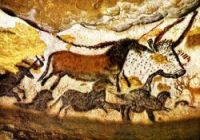
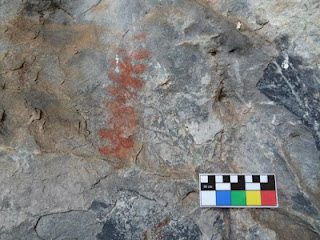
.jpg)
